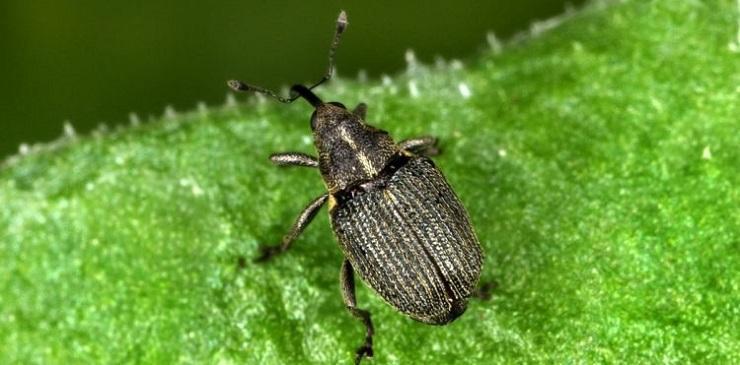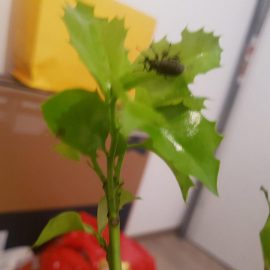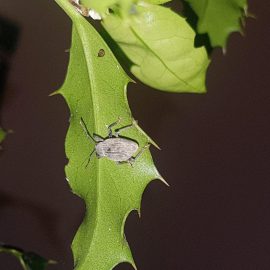Cabbage seedpod weevil (Ceutorhynchus assimilis) – pest management

The cabbage seedpod weevil, Ceutorhynchus assimilis is a widespread pest in Europe, Asia, North America, and Africa. It can be found in all areas where rapeseed is cultivated, causing great damage to plants from the Cruciferae family.
Description. The adult has a body that is 2-3 mm long, black in color, and covered with fine, gray hairs. The pronotum has a visible tuber, located in a slightly transverse position. The larva doesn’t have any feet, is white-yellow in color, and has a curved body, 3-5 mm long. The cephalic capsule is brown. The eggs are oval, and milky white, and take about 10 days to hatch, depending on the temperature.
Life cycle. It is a species that produces one generation per year and overwinters in the adult stage, in the surface layer of the soil. When temperatures exceed 12° C, in April-May, the adults leave the overwintering place and migrate to the spontaneous cruciferous plants, until the sprouting of the cultivated cruciferous vegetables.


The cabbage seedpod weevil feed for 40-70 days until sexual maturity, after which they mate and the females lay eggs. The female makes a hole in the wall of the silique and lays one egg at a time, succeeding to lay up to 35-50 eggs. After hatching, after 35-40 days, during which the larva develops, it leaves the silique and retreats to the surface layer of the soil and pupates. The pupal stage lasts 10-15 days after which the new adults appear. They feed on spontaneous cruciferous plants and cultivate cruciferous vegetables until autumn when they retreat for overwintering in the surface layer of the soil.
Crop damage
This pest attacks spontaneous cruciferous plants and cultivated cruciferous vegetables (rapeseed, mustard, cabbage, cauliflower, and kale). Adults made cavities in the stems, peduncles, and flower buds and the larvae consume the seeds. The larvae attack the inside of the siliques, consuming the raw seeds. A larva can consume 3-10 seeds during its development. The resulting holes allow the penetration of pathogenic fungi and specific mosquitoes (Dasineura brassicae). The attack is massive when the temperatures are high, during the flowering period.
Pest management
It is recommended to apply agrotechnical measures such as deep plowing carried out in autumn, the removal of the spontaneous cruciferous plants, and the destruction of plant debris after harvest.
The application of insecticides should be done in case of a warning or before reaching the economic threshold, of 1 adult per every 2 plants. Both contact and systemic insecticides must be used.
During the laying of the eggs, some of the plant’s branches are in bloom and, thus, visited by pollinators.
Treatments must be carried out with specific insecticides, which protect the pollinators.
Recommended products
-
You can find products on a different store
Change Store -
You can find products on a different store
Change Store -
You can find products on a different store
Change Store -
You can find products on a different store
Change Store -
You can find products on a different store
Change Store -
You can find products on a different store
Change Store -
You can find products on a different store
Change Store -
You can find products on a different store
Change Store -
You can find products on a different store
Change Store -
You can find products on a different store
Change Store -
You can find products on a different store
Change Store -
You can find products on a different store
Change Store -
You can find products on a different store
Change Store -
You can find products on a different store
Change Store -
You can find products on a different store
Change Store -
You can find products on a different store
Change Store -
You can find products on a different store
Change Store -
You can find products on a different store
Change Store -
You can find products on a different store
Change Store -
You can find products on a different store
Change Store -
You can find products on a different store
Change Store -
You can find products on a different store
Change Store -
You can find products on a different store
Change Store -
You can find products on a different store
Change Store


















































































































































































































































































































































































































































